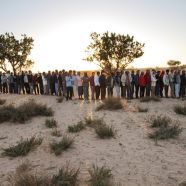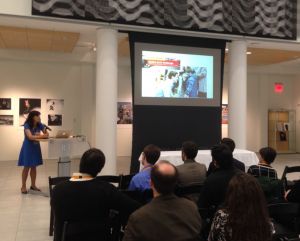
Refugees from Libya Queue for Food at Tunisia Transit Camp. UN Photo/OCHA/David Ohana. http://tinyurl.com/jx9etbb
Share This
Print This
Email This
The Impact of Framing Migration as Crisis
What does it mean to frame human migration with sensational terminology, such as the term crisis? How does language, often associated with intractable problems such as humanitarian or environmental disasters, or political stalemates, shape the responses to rapidly expanding transnational human mobility? These are some of the questions examined at a recent conference in Rochester, New York, in April 2016, partly with the goals of understanding the nature of migration “crisis,” the implications of framing migration as a “crisis,” and the history of and present status of “crisis” frameworks, management theories, and problem-solving.
The annual Conable Conference in International Studies, which I have been convening for the past six years at the Rochester Institute of Technology, critically explores themes and issues that are current and timely and intersect with my own research on global mobilities, such as trafficking, slavery, and labor coercion. The 2016 conference featured thirty-four speakers and two keynotes. The inspiration for the 2016 theme was the rapidly global unfolding humanitarian drama of mass migration. The United Nations High Commissioner for Refugees’ emergency handbook describes crisis as an emergency “situation in which the lives, rights, and well-being of humans are or will be threatened unless immediate and appropriate action is taken.” Informed by political rhetoric and sensationalizing media, the steering committee decided to focus on the framing of migratory movements as a crisis. Previous conferences have considered asylum and refugee law and the role of expertise, gender violence and forced marriage, and exile and deportation. The conferences are public and participants are selected from a transparent, peer-reviewed submission process. A number of interdisciplinary peer-reviewed volumes have emerged from these conferences. Here I provide a brief overview of the some of the presentations at the conference and contextualize them and their broader significance.
The two keynote speakers were invited to address the theme explicitly and set the tone for the two-day meeting. Idil Atak, a Turkish-Canadian national, assistant professor of criminology, and current president of the Canadian Association for Refugee and Forced Migration Studies, began with the relatively uncontroversial observation that because migration is a global phenomenon, with an estimated 232 million migrants in the world, affecting most states, a comprehensive framework for migration governance is still lacking. She then pivoted to explain how, because of this absence, in the last decades, and especially following the terrorist attacks of 9/11, what is routinely referred to by scholars as “irregular migration” has been reframed in many domestic political agendas as constituting a threat to state sovereignty and the integrity of the welfare state. Previous policies and practices of traditional immigration and refugee law have been fundamentally distorted by national security concerns.
Audie Klotz, a professor of political science in the Maxwell School of Citizenship and Public Affairs at Syracuse University, tackled the relationship between security and rights. Migration, Klotz argued, inherently invokes change, but the causes and consequences elude prediction. Outbreaks of violence sporadically spur individual mobilities, and economic fluctuations affect employment demands and outcomes. Klotz highlighted the tensions between migration networks that constantly reinvent pathways to desired destinations, and policymakers who continually seek ways to disrupt migration routes. Against this tension, personal relationships often defy the logic of markets or the demands of resettlement agencies. The key contradiction for Klotz is that whereas migration plays a crucial role in creating the underlying structures of contemporary global politics, domestic political realities try vainly to restrict it.
Framing mobility as a crisis operates as a call for action, and it engages disparate constituencies in complex ways. Mark Reeves, from the University of North Carolina at Chapel Hill, argued that while current popular sentiment in Europe and the United States is at a frenzied level over the supposed threat posed by “unwashed masses” of refugees and “unskilled” labor migrants, in an earlier imperial era the term “crisis” was attached to colonial elites. Crises of colonial governance in British India and French-mandated Syria led European governments to negotiate decolonization, paralleling a negotiated decolonization in the U.S.-ruled Philippines. Reeves shows that by refocusing the idea of a “migration crisis” onto elites who challenged colonial power, current fears are revealed as deeply class-based. When we recognize the power of individuals to manufacture political crisis for imperial states in the past, the layered motivations undergirding contemporary anti-migration rhetoric are rendered more tangible.
Crisis often operates as a call for help, but it is also a term that situates relationships between mobile communities and the nations or countries whence they relocate. As Serdar Değirmencioğlu from Dogus University in Turkey argued, framing migration as a crisis implies an alternative non-crisis state, an imaginary business-as-usual paradigm where people roam freely. Other scholars explored the nature of crisis “management,” a rapidly expanding site of study and humanitarian agency operation, but one with important albeit neglected antecedents. Bennett Sherry, from the University of Pittsburgh, utilizing a neglected collection of UNHCR archival documents and Turkish jurisprudence, explored how the UNHCR branch office in Ankara managed to expand its operations to serve an influx of non-European refugees in the 1980s, from Iran in particular, while Turkey maintained geographic restrictions on mobility.
In many respects the framing of migration as crisis is a reflection of local and national political dynamics, and has little to do with the dimensions and flows of vulnerable people. Elżbieta Karolina Wiącek, from Jagiellonian University, in Krakow, Poland, noted how difficult it is to draw a line between the pro-refugees Poles and those opposed to further refugee intake. Contrary to many media presentations, there is no neat division between the political leadership and “ordinary” citizens. In both groups, one can find a variety of attitudes. For example, Jaroslaw Kaczynski, leader of the Law and Justice Party, currently the largest party in the Polish parliament, warned that refugees from the Middle East could bring dangerous disease and parasites to Poland. Wiącek notes that one of the major factors behind anti-migrant views is Poland’s religious and ethnic homogeneity. Barely 0.1 percent of the country’s population consists of foreigners. Similarly, as Loubna Ali Khalil’s research showed, the conflict dynamics in Lebanon have evolved due to political failure rather than the refugee influx in itself. The conflicts in fact reflect—argued Ali Khalil from Rhur University of Bochum, Germany—the interest of politicians in framing the refugee influx as a conflict to cover up political and institutional failures.
Crisis language is deliberately obfuscating and is anchored in deeper misunderstandings of the relationships between migration, asylum, and refugees. Once migration is framed as crisis it is almost impossible to locate accurate data on sentiment. Alyssa Jackson, an undergraduate in International and Global Studies at RIT, considered how specific crises are reframed as human interest stories in the United States in order to elicit empathic responses. At the same time, however, the depth of knowledge about specific crisis zones, such as Syria, was greater in countries such as Canada where narrower political reporting prevailed over human interest narratives. Alexander Caviedes, from the State University of New York, Fredonia, examined published newspaper media for linkage between asylum and immigration and found that the two were treated with equal frequency across Europe. In several countries the term crisis is commonly associated with asylum, and the frequency of references to asylum in the press mirrored actual trends in the numbers of applicants within several countries, including Spain, Germany, and France. In the UK, however, crisis rhetoric seems to have completely distorted the relationship.
But crisis language has even deeper reverberations in society. Keren Snider, from the University of Haifa, explored how exposure to political violence affects attitudes toward asylum seekers in Israel. She was curious to understand how perceptions of threats from one group might translate into support for harsh governmental asylum policies. Over the past ten years, more than 60,000 asylum seekers from Sudan and Eritrea have entered Israel (representing 1 percent of population). A survey of civilian attitudes toward asylum seekers in wartime found that different levels of exposure to the Israeli-Palestinian conflict impacted perceptions among diverse populations. Asylum is relatively new in Israel, yet it receives substantial public and media attention, and government officials are referring to it as a dangerous crisis in the making.
Perhaps most puzzling of all is why one crisis appears to receive more attention than another. If crisis really means something, how is it that all crises are not equal. Several scholars attempted to discern patterns to the labeling of crisis. Isabelle Sauriol, an independent scholar and lawyer in Montreal, Canada, considered what motivate the international news media to focus more on the Syrian refugee crisis than five other major humanitarian crises that occur simultaneously. Sauriol and Amanda Schartau—also an RIT undergradate—offered similar and competing hypotheses for the discrepancies in reporting and international responses highlighting the various number of casualties, the total military expenditure, the number of children involved, the political leverage and economic interests of parties, cultural ties between the communities, the duration of the conflict, and the rhetoric of new media.
The conference was fascinating and provocative. The conversations highlighted the global scope of the “crisis” conceptualization, as well as its regional and national iterations, such as the Australian response to refugee movements in the oceans north of the island-nation, the Mexico-U.S. border, or the Mediterranean and Balkan overland routes into the European Union. The participants and audience discussed how crisis language ushers in hasty responses, stimulates fraught political rhetoric, and resonates with persistent national and international political, economic, social, cultural, and religious tensions. We came away with a strong sense that crisis language mobilizes diverse resources, garners journalistic and public attention, and instantiates emotional, moral, and ethical engagement in complex and challenging ways.








Dysphemisms and euphemisms within every culture both create and reflect the ideologies found within them. Sadly truth is ‘framed’ by language. It is up to every individual to discard the frames. The dismantling of such requires empathy moreso than objectivity; empathy without bias or discrimination. The crisis becomes the opportunity and not the problem. The problem is the perception of others. The opportunity is in seeing there are no ‘others’. Any one of us could be ‘them’. Real solutions being at this point in vision.